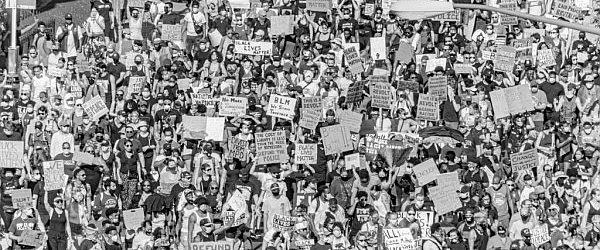On 21 June, Pauline Hanson introduced a motion to the Australian Senate that called for the Government to reject critical race theory from the national education curriculum. Despite the fact that Hanson invoked a set of diverse theories and practices that cannot be reduced to a singular position, and despite the fact that no such organised curriculum is currently taught in schools, the motion passed the Senate with the support of members of the sitting Coalition Government.
Hanson’s motion is symbolic, designed to add fuel to a culture war that is already raging. Yet its effects are concrete – they signal a coordinated attack by those who hold public office on principles of anti-racism. This should concern everyone who cares about equality and justice.
The moral panic over critical race theory turns on an idea that teaching racial literacy produces ‘cancel culture’, closes down free speech, and promotes division and hatred. It is presented as a dangerous propaganda project that must be stopped. A central claim of the attackers is that critical race theory leads to racism against white people. However, racism cannot be inverted in this way, as it describes a systemic relation to power manifest in acts that produce racial hierarchies. In addition, the call to ban or reject critical race theory because it supposedly curtails free speech is in itself an act of censorship that must be understood as an attempt to protect racism from condemnation and critique. Such attacks diminish and marginalise the experiences of those who suffer from racism, forcing them to take defensive positions that trap discourse around racism into questions of intention rather than effect. This discursive sleight-of-hand upholds and entrenches racism by presenting it as a right to expression rather than an act of violence.
This latest manifestation of the ongoing culture wars dismisses theoretical, pedagogical and activist work that take critical approaches to race – work that interrogates how race has come to be constructed and what effects it continues to have on the way people live and die. The attacks on ‘critical race theory’ take issue with the idea that race and racism are structural phenomena, continuously reinvented through policy, law, social norms, public health, bureaucracy, education and so on. The attack is a dog whistle disguised as a debate, with the twin goals of disempowering those who experience racism and dampening collective responses against racism.
This position was reiterated by former Prime Minister John Howard – a man who oversaw the suspension the Racial Discrimination Act (1975) on two separate occasions (1998 and 2007) – when he commented during an ABC broadcast: ‘I don’t think there is underlying racism in Australia.’
Howard’s comment asserts that racism should be understood as the aberrant behaviour of individual ‘bad apples’ rather than a foundational technology of the settler colony that continues to structure the nation. Moreover, this position passes-off as natural the constructedness of what Distinguished Professor Aileen Moreton-Robison calls ‘the possessive logic of patriarchal white sovereignty’, which describes the way the settler claim to sovereignty is asserted over and over again via processes that seek to negate Indigenous sovereignty.
Thinking critically about race in the context of the settler colony is to acknowledge the illegitimacy of the settler state – to recognise and support Indigenous sovereignty. The process of decolonisation, as Frantz Fanon teaches us, ‘sets out to change the order of the world’ and it is this agenda that provokes these current attacks.
Why should we think critically about race?
Racism makes some people vulnerable to premature death and creates barriers to accessing resources, infrastructures and services necessary for living. The failure to properly grasp what race is and what racism does is an obvious barrier to anti-racist action.
The current attacks on critical race theory misunderstand race in a number of dangerous ways: firstly, they presume there is a natural biological essence to race; secondly, they advance the notion that racism is simply the moral or ethical shortcoming of an individual; thirdly, they protect racism from condemnation by weaponising the idea of free speech.
Critical theorisations of race work against these false assumptions. In the first instance, scholars of race show how race is constructed through the repetition of ascriptive acts. The cultural theorist Stuart Hall once said that ‘race is a floating signifier’, by which he meant that there is no fixed essence to race but that race is made and remade through cultural practices that produce designations.
In other words, and as the scholars Barbara and Karen Fields put it, race is the result of the repetition of acts of racism and not the other way around. Critical approaches to the study of race are concerned with understanding the way race is produced and its unjust effects. The reduction of racism to individual intolerance fails to grasp what racism does: racism describes the ascription of difference that produces hierarchies that in turn naturalise race. In other words, racism has the effect of transforming an action into something that appears to be a thing, namely race. Critical theories of race ask us to attend to how this occurs in order that we may intervene in it. This is not ‘cancel culture’ but a call for modes of critical thinking that seek to understand histories of oppression and how they are remade in the present.
Critical race history asks that we study both histories of racialisation and racism, and the way these histories shape institutions and daily life.
Take, for example, the disproportionate number of First Nation deaths in custody. Such deaths are not the product of inherent criminality nor an increased susceptibility to death but are inextricably linked to the violent processes of invasion and occupation that Australia is founded upon. The over-representation of Indigenous people in prisons must be understood in relation to forms of racialisation that over the history of Australia include invasion, frontier genocide, forced relocation to missions and reserves, forced removal of children from families and kinship formations, infrastructural neglect on the part of the state.
The legal scholar Alison Whittaker describes the way legal processes such as coronial inquests also work to explain Indigenous deaths in custody as natural and inevitable:
Coroners, in their long careers examining death, are trained to look for biomedical models. It is unremarkable that they find that most deaths inside are from natural causes. What they and we often fail to see is how designating a death as natural commonly misrepresents how someone died inside, implying that nothing caused or contributed to it.
Here we can start to see how the legal systems themselves uphold and reinscribe racial stereotypes. The failure to consider how death might arise from racially motivated violence or neglect and how it is connected to ongoing colonial violence skews the narrative about deaths inside and contributes to the pathologisation of First Nations people.
Behind the attacks on critical race theory is the fear that collective anti-racist mass movements are gaining widespread appeal. It is no surprise that this wave of attacks follows a year of global uprisings and mass movements that have seen millions of people take to the streets to challenge white supremacy and assert that Black life matters.
The attacks on critical race theory are an attempt to dismiss collective movements that will not be so easily moved. The idea that critical race theory is responsible for brainwashing young people into joining anti-racist movements is both ridiculous and offensive. Such a claim implies that people involved in anti-racist struggles have no capacity to evaluate information and reflect on how it relates to the world they live in. It implies that people have no desire to dismantle systems that perpetuate misery and violence. And it cloaks the fact that such attacks are motivated by an ideological position that is hell-bent on resisting change.
Collective anti-racist movements, such as the rolling BLM protests or the more recent Palestinian solidarity marches, are building momentum because – through lived experience –people are able to understand that structures such as capitalism and settler colonialism are inextricably tied to racism. Theory attempts to make sense of events in the world and so if an engagement with critical theories of race allows people to better understand the operations of racism and leads them to action, then this is something to celebrate. So while race-critical approaches are not formally part of a national curriculum, we should work to find ways to incorporate such pedagogy into everything we do in the hope that it leads to the expansion of collective anti-racist movements.
See also the open letter in response to the passing of Pauline Hanson’s motion. This open letter – signed by more than 500 people – is a collective statement against racism and the current attacks on ‘critical race theory’. The signatories to this letter are committed to First Nations sovereignty, anti-racism, and critical scholarship.
Image: Flickr






